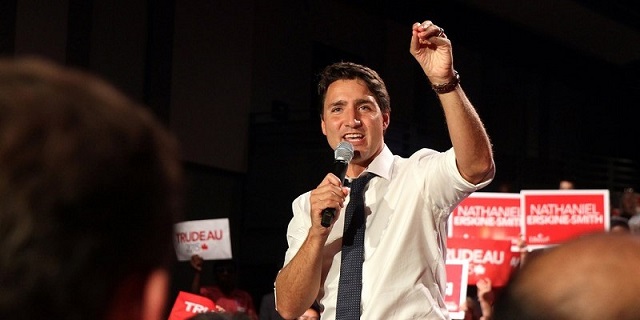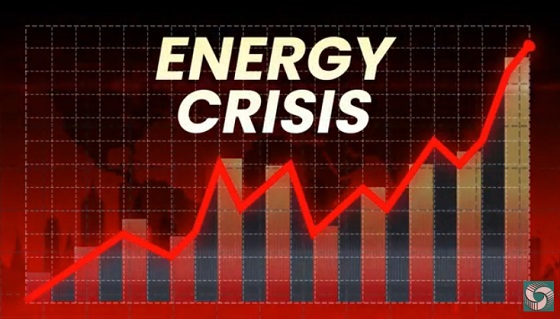Energy
Fossil fuel consumption rising despite ‘net-zero’ plans worldwide

From the Fraser Institute
By Julio Mejía and Elmira Aliakbari
During a recent speech in Brazil, U.S. Treasury Secretary Janet Yellen said that “many sources”—including governments—must spend “no less than $3 trillion” each year for the world to achieve “net-zero” global carbon emissions by 2050. While Yellen was light on specifics, she said the money would pay for “clean energy technologies” and “pathways to sustainable and inclusive growth.”
But to achieve net zero, which means either eliminating fossil fuel generation or offsetting the emissions generated through activities such as planting trees, countries must phase out the world’s primary energy source (fossil fuels such as oil and gas), defying the global trend of increasing fossil fuel consumption.
Indeed, between 1997 (when the original Kyoto Protocol was ratified) and 2023, the share of total global energy represented by fossil fuels declined slightly from 85.7 per cent to 81.5 per cent. However, during that same period the actual use of fossil fuels has increased dramatically with global consumption of coal, gas and oil increasing by 56 per cent.
Here in Canada, despite billions spent and almost a decade of new taxes and regulations in the Trudeau government’s pursuit of net zero by 2050, the share of fossil fuels in our total energy consumption increased from 64.6 per cent in 2015 to 65.0 per cent in 2023. Clearly, the Trudeau government’s carbon tax, regulations and policies meant to phase out fossil fuels have not achieved this goal.
But this comes as no surprise. Massive energy transitions are slow and take centuries. Renowned scholar Vaclav Smil’s recent study explained that the first global energy transition—from traditional biomass fuels (including wood and charcoal) to fossil fuels—started more than two centuries ago and unfolded gradually. In fact, the transition away from biomass fuels remains incomplete. Nearly three billion people in the developing world still depend on charcoal, straw and dried dung for cooking and heating, accounting for about 7 per cent of the world’s energy supply (as of 2020).
According to Smil, coal only surpassed wood as the main energy source worldwide around the year 1900. It took more than 150 years from its first commercial extraction for oil to reach 25 per cent of all fossil fuels consumed worldwide, reaching this milestone in the 1950s. And natural gas reached this threshold at the end of the 20th century, after 130 years of the industry’s development.
So, let’s look at what net-zero advocates are proposing in a different way. For the world to reach net zero by 2050, the amount of energy humanity must replace with new sources (e.g. wind, solar) is 23 times greater than the amount of energy the world used when the previous transition started in the 19th century. And governments want to achieve this unprecedented transition in less than one-eighth of the time of the previous transition.
While politicians worldwide talk about a great energy transition, fossil fuel consumption has only grown. And it’s the same story here at home. Clearly, achieving net zero by 2050 is neither realistic nor feasible.
Authors:
Energy
Federal Clean Power Plan Risks Blackouts And Higher Bills

From the Frontier Centre for Public Policy
Ottawa’s Clean Electricity Regulations could derail Canada’s energy future. Here’s what we need to do
The federal government’s push to make Canada’s electricity system net-zero is running straight into reality—and it’s not pretty.
Through the Clean Electricity Regulations (CER), the government wants all provinces to eliminate greenhouse gas emissions from electricity generation by 2035. It is an ambitious goal, but one that ignores a basic fact: demand for electricity is exploding, and provinces are struggling to keep up.
New technologies like artificial intelligence are supercharging this demand. AI systems, including tools such as ChatGPT, rely on massive data centres—huge warehouses of computer servers that need constant cooling and enormous amounts of electricity to function. According to a recent Royal Bank of Canada report, if all proposed data centre projects in Canada move ahead, they would consume 14 per cent of the country’s entire electricity supply by 2030. That is roughly the same as projections in the United States, where data centres are expected to use up to 15 per cent of the national total.
This is a serious problem. Provinces such as Alberta and Saskatchewan have already raised the alarm, arguing that the federal regulations overstep Ottawa’s constitutional authority. Energy supply, like natural resources, has traditionally been under provincial control. Alberta and Ontario operate their own electricity markets to attract investment and ensure reliability. Federal regulations threaten to undermine these efforts, adding risk and driving up costs.
The situation is already tense. Alberta, for example, issued multiple grid alerts in 2024 due to shortages and market disruptions. The province is now looking at “behind-the-fence” power solutions, encouraging data centres to generate their own electricity to guarantee stability.
Canada was not always in this bind. For decades, we enjoyed an abundance of clean, affordable hydroelectric power. Provinces like Quebec, British Columbia, Manitoba and Newfoundland and Labrador built massive hydro projects starting in the 1960s, creating cheap power and even surpluses to export to U.S. markets. In 2022, for example, B.C. sent 74 per cent of its exported power to the U.S., while Quebec sent 63 per cent and Ontario an impressive 81 per cent, generating billions in revenue.
But that era is coming to an end. Most of the best sites for hydro dams have already been developed. New projects would require expensive, long-distance transmission lines to bring power from remote areas to the cities that need it. On top of that, growing environmental concerns make new dam construction an uphill battle.
The truth is, there is no quick fix. A 2025 study by the Fraser Institute paints a grim picture: to meet future electricity demand solely with solar power would require 1,680 years of construction. Wind power? About 1,150 years. Even hydro would take close to a millennium. Even if we combined these sources, we are still looking at more than 1,000 years to build enough capacity.
Meanwhile, federal projections estimate that Canada’s electricity demand will double by 2050.
Without significant policy changes, Canadians could soon face the worst of both worlds: soaring electricity bills and the threat of power shortages. Our economy could also suffer as companies and data centres look to other jurisdictions with more reliable power supplies.
So what should Canada do? Here are three practical steps:
- Scrap the Clean Electricity Regulations. Provinces like Alberta and Saskatchewan are already committed to reaching net-zero by 2050. Federal interference only creates unnecessary political battles and delays investments.
- Fast-track approvals for new interprovincial transmission lines. Today, building a new transmission line can take more than a decade. Speeding up this process would help provinces share power and avoid costly overbuilding of generation capacity.
- Launch a major low-interest loan program to build new power infrastructure. We need to dramatically expand our generation and transmission systems, including natural gas-fired plants, to meet future demand.
Canadians deserve a reliable, affordable and clean energy future. But we will not get there by ignoring the realities of rising demand and provincial responsibilities. It is time for the federal government to listen to the provinces, embrace practical solutions and avoid an avoidable crisis.
Otherwise, we are on track for blackouts, higher bills and missed economic opportunities.
Maureen McCall is an energy business analyst and Fellow at the Frontier Center for Public Policy. She writes on energy issues for EnergyNow and the BOE Report. She has 20 years of experience as a business analyst for national and international energy companies in Canada.
Economy
The Net-Zero Dream Is Unravelling And The Consequences Are Global

From the Frontier Centre for Public Policy
The grand net-zero vision is fading as financial giants withdraw from global climate alliances
In recent years, governments and Financial institutions worldwide have committed to the goal of “net zero”—cutting greenhouse gas emissions to as close to zero as possible by 2050. One of the most prominent initiatives, the Glasgow Financial Alliance for Net Zero (GFANZ), sought to mobilize trillions of dollars by shifting investment away from fossil fuels and toward green energy projects.
The idea was simple in principle: make climate action a core part of financial decision-making worldwide.
The vision of a net-zero future, once championed as an inevitable path to global prosperity and environmental sustainability, is faltering. What began as an ambitious effort to embed climate goals into the flow of international capital is now encountering hard economic and political realities.
By redefining financial risk to include climate considerations, GFANZ aimed to steer financial institutions toward supporting a large-scale energy transition.
Banks and investors were encouraged to treat climate-related risks—such as the future decline of fossil fuels—as central to their financial strategies.
But the practical challenges of this approach have become increasingly clear.
Many of the green energy projects promoted under the net-zero banner have proven financially precarious without substantial government subsidies. Wind and solar technologies often rely on public funding and incentives to stay competitive. Energy storage and infrastructure upgrades, critical to supporting renewable energy, have also required massive financial support from taxpayers.
At the same time, institutions that initially embraced net-zero commitments are now facing soaring compliance costs, legal uncertainties and growing political resistance, particularly in major economies.
Major banks such as JPMorgan Chase, Citigroup and Goldman Sachs have withdrawn from GFANZ, citing concerns over operational risks and conflicting fuduciary duties. Their departure marks a signifcant blow to the alliance and signals a broader reassessment of climate finance strategies.
For many institutions, the initial hope that governments and markets would align smoothly around net-zero targets has given way to concerns over financial instability and competitive disadvantage. But that optimism has faded.
What once appeared to be a globally co-ordinated movement is fracturing. The early momentum behind net-zero policies was fuelled by optimism that government incentives and public support would ease the transition. But as energy prices climb and affordability concerns grow, public opinion has become noticeably more cautious.
Consumers facing higher heating bills and fuel costs are beginning to question the personal price of aggressive climate action.
Voters are increasingly asking whether these policies are delivering tangible benefits to their daily lives. They see rising costs in transportation, food production and home energy use and are wondering whether the promised green transition is worth the economic strain.
This moment of reckoning offers a crucial lesson: while environmental goals remain important, they must be pursued in balance with economic realities and the need for reliable energy supplies. A durable transition requires market-based solutions, technological innovation and policies that respect the complex needs of modern economies.
Climate progress will not succeed if it comes at the expense of basic affordability and economic stability.
Rather than abandoning climate objectives altogether, many countries and industries are recalibrating, moving away from rigid frameworks in favour of more pragmatic, adaptable strategies. Flexibility is becoming essential as governments seek to maintain public support while still advancing long term environmental goals.
The unwinding of GFANZ underscores the risks of over-centralized approaches to climate policy. Ambitious global visions must be grounded in reality, or they risk becoming liabilities rather than solutions. Co-ordinated international action remains important, but it must leave room for local realities and diverse economic circumstances.
As the world adjusts course, Canada and other energy-producing nations face a clear choice: continue down an economically restrictive path or embrace a balanced strategy that safeguards both prosperity and environmental stewardship. For countries like Canada, where natural resources remain a cornerstone of the economy, the stakes could not be higher.
The collapse of the net-zero consensus is not an end to climate action, but it is a wake-up call. The future will belong to those who learn from this moment and pursue practical, sustainable paths forward. A balanced approach that integrates environmental responsibility with economic pragmatism offers the best hope for lasting progress.
Marco Navarro-Genie is the vice president of research at the Frontier Centre for Public Policy. With Barry Cooper, he is coauthor of Canada’s COVID: The Story of a Pandemic Moral Panic (2023).
-

 Energy2 days ago
Energy2 days ago‘War On Coal Is Finally Over’: Energy Experts Say Trump Admin’s Deregulation Agenda Could Fuel Coal’s ‘Revival’
-

 COVID-192 days ago
COVID-192 days agoThe Pandemic Justice Phase Begins as Criminal Investigations Commence
-

 Economy1 day ago
Economy1 day agoThe Net-Zero Dream Is Unravelling And The Consequences Are Global
-

 2025 Federal Election2 days ago
2025 Federal Election2 days agoBefore the Vote: Ask Who’s Defending Our Health
-

 2025 Federal Election1 day ago
2025 Federal Election1 day agoHomebuilding in Canada stalls despite population explosion
-

 2025 Federal Election2 days ago
2025 Federal Election2 days agoThe “Hardhat Vote” Has Embraced Pierre Poilievre
-

 2025 Federal Election14 hours ago
2025 Federal Election14 hours agoCarney’s Fiscal Fantasy: When the Economist Becomes More Dangerous Than the Drama Teacher
-

 Addictions1 day ago
Addictions1 day agoAddiction experts demand witnessed dosing guidelines after pharmacy scam exposed







